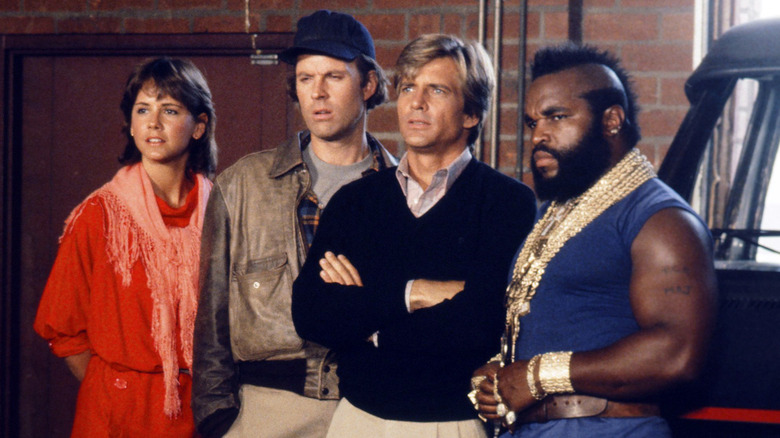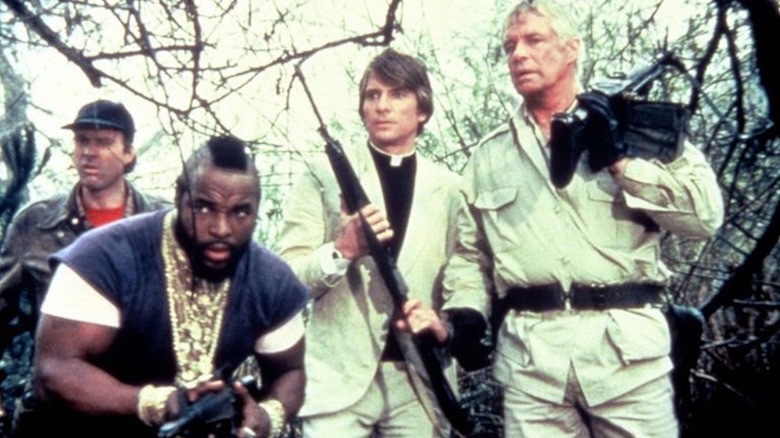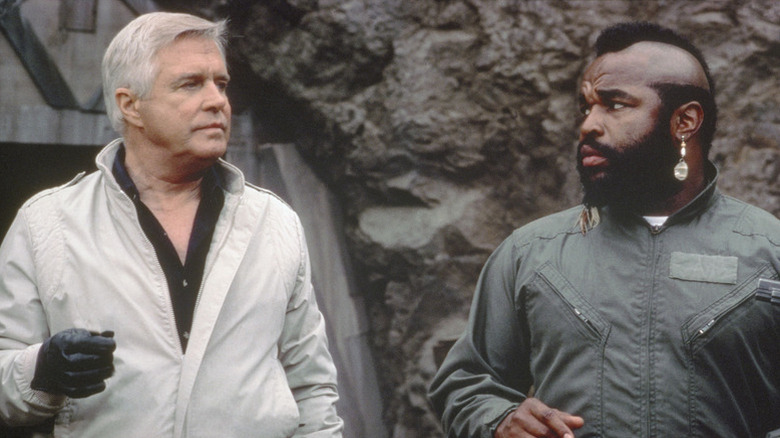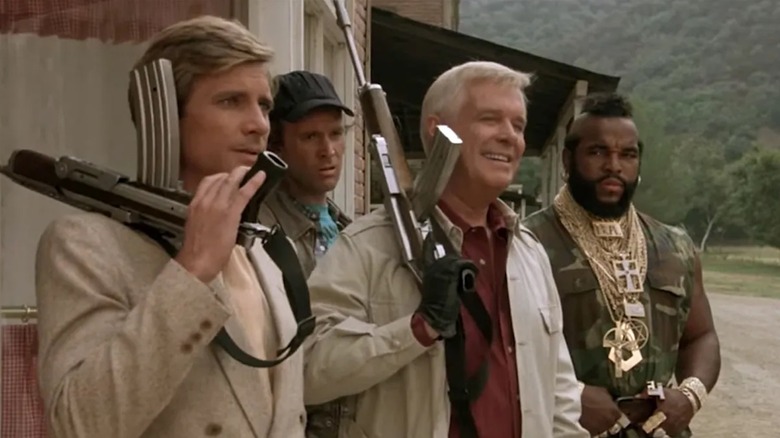Why NBC Suddenly Canceled The A-Team In The Middle Of A Season
We may receive a commission on purchases made from links.
When "The A-Team" blasted its way into the country's living rooms on January 23, 1983, NBC did not have high expectations for the show. But when the second episode — which aired after Super Bowl XVII (the one where Washington's John Riggins rushed with shocking impunity against Miami's defense) — scored sky-high ratings, the network realized it had a hit on its hands.
We enjoyed the familiar, occasionally contentious interplay between the savvy Lieutenant Hannibal Smith (George Peppard), Lieutenant "Faceman" Peck (Dirk Benedict), Sergeant B.A. Baracus (Mr. T), and pilot H.M. "Howling Mad" Murdock (Dwight Schultz), all of whom were fugitives from the military for being accused of crimes they did not commit. And, perhaps most importantly for the era, we loved their use of various firearms and improvised weaponry.
"The A-Team" was a top-ten Nielsen ratings show over its first three seasons. It was as popular as "Monday Night Football," and owned the Tuesday night 8 p.m. slot. That was family hour on primetime television, which meant "The A-Team" had to essentially function as a live-action cartoon. Co-creator Stephen J. Cannell and his writers could employ all the high-tech weaponry they wanted and blow up all manner of vehicles, but, as former "The A-Team" writer Mark Jones told me in 2023, they couldn't kill anyone.
"The A-Team" ranked sixth in the Nielsen ratings at the conclusion of its third season and seemed poised for a long run, but viewers abruptly abandoned the show in season 4. It finished 30th that year in the ratings due in large part to ABC premiering two wildly popular, family-friendly sitcoms in "Who's the Boss" and "Growing Pains." NBC tried to save the show in season 5 by initially moving it to Friday, then back to Tuesday (this time at 9:00 PM) and finally to Sunday, but its already dwindling viewership was cut in half. When it was clear viewers had moved on from "The A-Team," NBC canceled it mid-season. How did such a once massively popular show die such a speedy death?
What happened in the fifth season of The A-Team?
It's rarely a good sign when a struggling show introduces new characters to spice up its rigidly formulaic plotlines. Cast replacements are fine ("Cheers" brilliantly pulled this off twice), but pulling a "Brady Bunch" and going the Cousin Oliver route is typically a sign of impending cancellation.
At the outset of season 5, Hannibal is captured by the retired General Hunt Stockwell (Robert Vaughn), which results in the entire team being apprehended and court-martialed. Stockwell encourages the team to escape prison, whereupon he'll send them on a series of clandestine missions, which, if successfully executed, will earn them a Presidential pardon. To assist them on their perilous operations, they gain a new member of the team, Frankie Santana aka "Dishpan Man" (Eddie Velez). He's a neurotic like Murdock, and has a character quirk of being afraid to travel by sea (which placed him at tedious odds with B.A., who famously harbors a flying phobia).
Other alterations included a tweak of the opening credits. The producers dropped the narration (which was now irrelevant because the team were no longer fugitives), and, perhaps bowing to the era's music fad, eschewed the orchestral theme for a synth-heavy rendition. Each episode was as action-packed as ever, the hook of a potential pardon held some appeal, and Stockwell being a shady dealer added suspense as to the legitimacy of his offer. Quality-wise, aside from the annoying addition of Frankie, it was a perfectly average season of "The A-Team." The problem is that no one was watching.
What did The A-Team cast say about the cancellation?
As "The A-Team" entered season 5, there was a strong sense among some of the cast that this would be the series' swan song. Newcomer Eddie Velez certainly felt that way. As he told YouTuber Jim Conlan:
"What I understood was that they all knew it was the final season. What I heard was that at the end of the fourth season, the ratings were so low they were talking about cancelling it. But because the show had held the network up, it was the only hit show they had for a while there, they needed exactly 13 more episodes to make 100, which was what you needed then to go into syndication. And the network as a favor to Stephen Cannell, because he had been so good to the network, said, 'We'll give you 13 more episodes." But they also said, 'You've got to change it up a little, spice it up somehow.' And that's when they came up with the international angle and bringing in Robert Vaughn."
"The A-Team" actually closed out with 98 episodes, but maybe the network did some charitable math to help nudge it over the syndication threshold (though I remember the show disappearing for a long time after its cancellation).
As for TV veteran Vaughn (best known as David McCallum's co-star on "The Man from U.N.C.L.E."), he told the Archive of American Television that he was offered a handsome salary to boost the ratings as the slippery General Stockwell. He was told the show would survive for maybe another couple of years, which it did not. This probably pleased him because he was flummoxed by Mr. T:
"One thing [Peppard] said to me before I did the show was, 'You've got to understand there's a guy named Mr. T. He's crazy, and you just have to accept his craziness. I can't stand it. I don't even want to see the guy, but I'm stuck with him.'"
Though Vaughn considered Mr. T "clinically insane," he worked through his co-star's eccentricities. Peppard, however, was less forgiving of Mr. T's antics. (It seems "The A-Team" actors didn't get along so well.) In an interview with Terry Wogan (which I can only find on a message board), the putative star of the series recalled that an irate Mr. T once demanded the firing of six crew members. When Peppard found out, he marched into Cannell's office, and told the show's creator he would quit the series if he acceded to Mr. T's demands. Ultimately everyone kept their job.
To be fair, Peppard could also be a diva. According to the late Hulk Hogan (quoted in the British tabloid The Express), who appeared on two episodes of "The A-Team," "Peppard and Mr. T hated each other with a passion." When Peppard called Mr. T "the worst actor on the show" in an interview, the mohawked badass parked himself outside his co-star's trailer and read all of the disparaging quotes from the piece out loud. Dwight Schultz also faulted Peppard for the bad vibes. "I think it created a lot of problems and tensions," he said. "I don't think that George accepted the fact that T was the star of the show." Dirk Benedict innocent!
Was The A-Team's final episode really its final episode?
Season 5 of "The A-Team" officially concluded on March 8, 1987, with an episode called "Without Reservations," but it was essentially a burn-off. The series true finale had aired on December 30, 1986 with the episode "The Grey Team," wherein Hannibal and the boys realize the promise of a pardon is a sham, forcing them to break off from Stockwell and go back to being a freelance unit that will once again allow them to help decent people being victimized by all manner of evildoers.
There was definitely a good deal of disappointment when "Without Reservations" aired, as it was little more than a rank-and-file adventure for the quintet. But it was a boon for Cannell fans, as it freed up the prolific television producer to focus on one of his very best series, "Wiseguy." That same year, he also gave the fledgling Fox network one of its first hit series with "21 Jump Street," which went on to become its own film franchise.
In any event, if you're planning a thorough rewatch of "The A-Team," keep in mind to watch "Without Reservations" before you throw on "The Grey Team." And always remember that George Peppard and Mr. T hated each other's guts.



